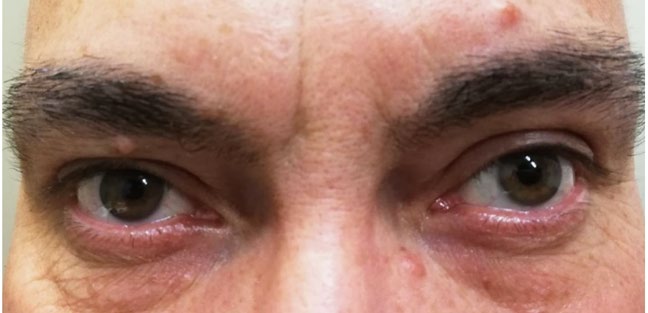Horner Syndrome, from Suspicion to Diagnosis Confirmation and Treatment
DOI:
https://doi.org/10.60591/crspmi.99Keywords:
Carotid Artery, Internal, Dissection, Horner Syndrome/diagnosis, Horner Syndrome/therapyAbstract
Horner syndrome (HS) is characterized by ptosis, miosis
and anhidrosis, due to an interruption of the oculosympathetic pathway along the cephalic, ocular or neck segments. This clinical case reports a 53-year-old man with a one week history of frontal headache, right ptosis and anisocoria. Cerebral and supra-aortic vessels angio-computed tomography was performed, excluding an acute ischemic or hemorrhagic event and carotid dissection. At the third apraclonidine test attempt, 8 days after admission, HS was confirmed. Then a cranioencephalic angio-magnetic resonance imaging was performed, revealing carotid dissection. The patient was proposed to initiate antiplatelet and antilipidemic therapy. After three months, he presented extracranial carotid dissection resolution. In this case, we emphasize the role of the apraclonidine test in this neurologic syndrome approach, and a conservative therapeutic approach allowed not only case resolution,
but also iatrogenic mitigation.
Downloads
References
Martin TJ. Horner Syndrome: A Clinical Review. ACS Chem Neurosci. 2018;9:177-86. doi: 10.1021/acschemneuro.7b00405.
Maloney WF, Younge BR, Moyer NJ. Evaluation of the causes and accuracy of pharmacologic localization in Horner's syndrome. Am J Ophthalmol. 1980;90:394-402. doi: 10.1016/s0002-9394(14)74924-4.
Morales J, Brown SM, Abdul-Rahim AS, Crosson CE. Ocular effects of apraclonidine in Horner syndrome. Arch Ophthalmol. 2000;118:951-4.
Salvesen R. Innervation of sweat glands in the forehead. A study in patients with Horner's syndrome. J Neurol Sci. 2001;183:39-42. doi:
1016/s0022-510x(00)00479-2. P
Kanagalingam S, Miller NR. Horner syndrome: clinical perspectives. Eye Brain. 2015;7:35-46. doi: 10.2147/EB.S63633.
Kardon R. Are we ready to replace cocaine with apraclonidine in the pharmacologic diagnosis of Horner syndrome? J Neuroophthalmol. 2005;25:69-70. doi: 10.1097/01.wno.0000172602.10008.18.
Kardon RH, Denison CE, Brown CK, Thompson HS. Critical evaluation of the cocaine test in the diagnosis of Horner's syndrome. Arch Ophthalmol.1990;108:384-7. doi: 10.1001/archopht.1990.01070050082036.
Wilhelm H, Ochsner H, Kopycziok E, Trauzettel-Klosinski S, Schiefer U, Zrenner E. Horner's syndrome: a retrospective analysis of 90 cases and recommendations for clinical handling. Ger J Ophthalmol. 1992;1:96-102.
Engelter ST, Grond-Ginsbach C, Metso TM, Metso AJ, Kloss M, Debette S, et al. Cervical Artery Dissection and Ischemic Stroke Patients
Study Group. Cervical artery dissection: trauma and other potential mechanical trigger events. Neurology. 2013;80:1950-7. doi: 10.1212/
WNL.0b013e318293e2eb.
Lee VH, Brown RD Jr, Mandrekar JN, Mokri B. Incidence and outcome of cervical artery dissection: a population-based study. Neurology. 2006;67:1809-12. doi: 10.1212/01.wnl.0000244486.30455.71.
Provenzale JM, Sarikaya B. Comparison of test performance characteristics of MRI, MR angiography, and CT angiography in the diagnosis of carotid and vertebral artery dissection: a review of the medical literature. AJR Am J Roentgenol. 2009;193:1167-74. doi: 10.2214/AJR.08.1688.
Debette S, Leys D. Cervical-artery dissections: predisposing factors, diagnosis, and outcome. Lancet Neurol. 2009;8:668-78. doi: 10.1016/S1474-4422(09)70084-5.
Chowdhury MM, Sabbagh CN, Jackson D, Coughlin PA, Ghosh J. Antithrombotic treatment for acute extracranial carotid artery dissections: a meta-analysis. Eur J Vasc Endovasc Surg. 2015;50:148-56. doi: 10.1016/j.ejvs.2015.04.034.
Engelter ST, Traenka C, Gensicke H, Schaedelin SA, Luft AR, Simonetti BG, et al. Aspirin versus anticoagulation in cervical artery dissection (TREAT-CAD): an open-label, randomised, non-inferiority trial. Lancet Neurol. 2021;20:341-50. doi: 10.1016/S1474-4422(21)00044-2.
Arauz A, Márquez JM, Artigas C, Balderrama J, Orrego H. Recanalization of vertebral artery dissection. Stroke. 2010;41:717-21. doi: 10.1161/STROKEAHA.109.568790.

Downloads
Published
How to Cite
Issue
Section
Categories
License
Copyright (c) 2024 Magda Costa, Ana Correia de Sá Correia de Sá, Joana Pires Pires, Filipe, Jorge

This work is licensed under a Creative Commons Attribution 4.0 International License.






